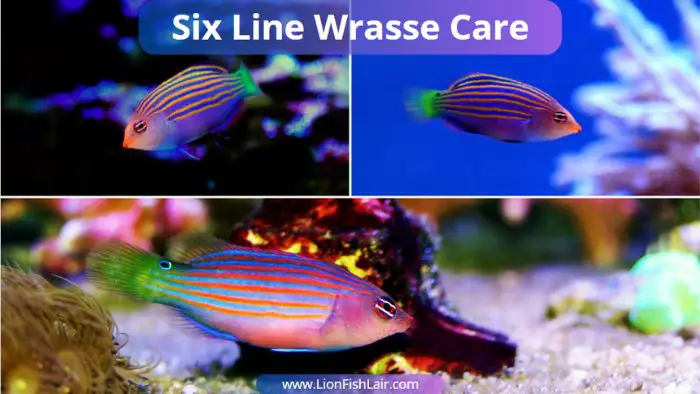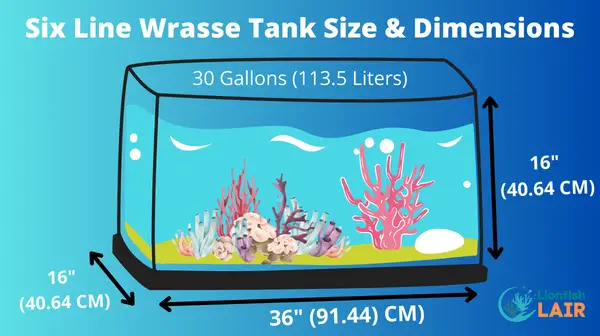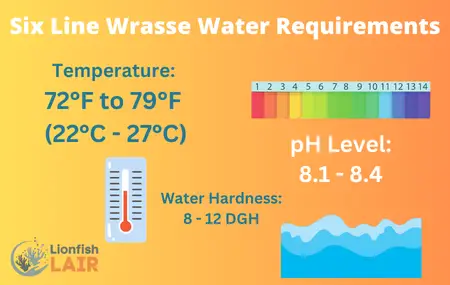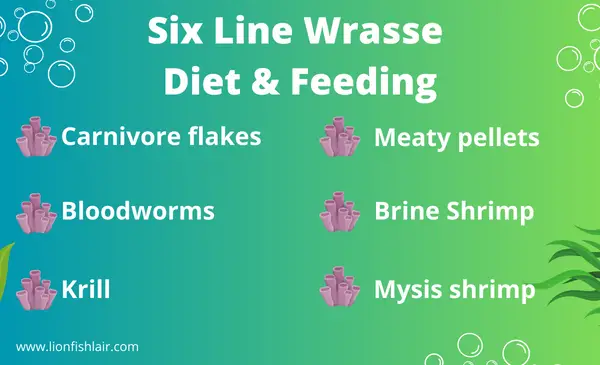The unique and colorful six-line wrasse is one of the most popular reef safe fish in the hobby, and for good reason too. They go by a few different names, with the notable ones being; Six Stripe Wrasse, Six Striped Wrasse, Striped Wrasse, and the scientific name is Pseudocheilinus Hexataenia.
It is extremely tough to argue a negative case against owning a six line wrasse when you look at their incredible neon blue bodies, accompanied by beautiful orange stripes seeping across their bodies. What is potentially the most striking feature to the fish, however, could be the piercing red eyes, with two white stripes running across them.

Main reasons for their huge popularity is their obvious beauty, which is showcased in the distinctive array of bright colors and patterns. Despite having somewhat of a reputation, most six line wrasses are peaceful and mild mannered.
Their behavior and comparitively low maintenance makes them a great choice for beginner hobbyists looking into a saltwater challenge. Now, without further ado, let's take a look at how you can successfully set up a six line wrasse tank and also care for these unique saltwater fish, with our ultimate six line wrasse care guide.
Six Line Wrasse Tank Requirements - How Do You Take Care of the Six Line Wrasse?
Whenever you purchase a new fish, and, or fish tank, before doing anything else, you must cycle the tank correctly, ensuring that you are meeting your fish's demands. Therefore, let's assume you have completed the nitrogen cycle for your saltwater fish tank, now we need to set it up for your six line wrasse!
Tank Size
Six line wrasses should be kept in a 30 gallon (136 liters) saltwater aquarium. If you can keep a larger tank, then do so, six-line wrasses are incredibly active and fast swimmers, they are alsovery nosey too and have been known to interact with their owners once they feel comfortable.
It is not a good idea to keep more than 1 male six line wrasse, but you can keep a female if you have a tank size of 55 gallons (208 liters) or more. Many hobbyists are interested in whether or not six line wrasses are "reef safe" or not. Fortunately, they are reef safe, for the most part.
Take a look at the graphic below for the classic dimensions and size of a six line wrasse aquarium:

Typically, six-line wrasses are known to not destroy or eat any coral, and they will leave invertabrates alone too. But this isn't to say that all of them won't, there have been some anomalies where people's six-lines have completely destroyed everything in their paths, so, this is certainly no guarantee.
Habitat and Decor
Despite being active swimmers, they are incredibly shy fish, and typically enjoy spending time hiding in little caves and coral formations. So, when decorating their tank, make sure that you provide them with plenty of good hiding spots, especially if they are first arriving to an established aquarium and fish community.
Due to the six line wrasse spending a significant amount of time at the bottom of the tank, or at least close to substrate, you will need to provide them with a sand substrate. Sand substrate is beneficial for them as their natural habitat is coral reefs, so, it will replicate this environment well.

Additionally, the sand substrate will create a stable environment for beneficial bacteria to grow and thrive, which help with maintaining your tanks' water quality.
Once they have established a territory, they will start being more adventurous, heading out into the open tank more and exploring new spots. The problem that can sometimes occour once these wrasses get comfortable is bullying.
In spite of most people not experiencing agressive six-line wrasses, there are some hobbyists that have claimed them to be complete nightmares! They have a small and somewhat unfair reputation for bullying smaller tank mates and other wrasses at times, but this can happen to any fish, despite having a naturally peaceful personality.
Temperature and Water Quality
They are used to fairly warm waters, so their temperature should range between 71.6°F to 80.6°F (22°C to 27°C). Additionally, six line wrasses require a pH level ranging between 8.1 and 8.4, a hardness of 8 to 12 DGH, and the gravity should be 1.020-1.025.
You can check out and download the graphic below for your reference:

Acclimatization
The fish acclimation process can be different from species to species, and for the Six Line Wrasse it is no different. Firstly, you will need to place your fish in a bucket and then drip acclimate for around an hour at a rate of 3 drips per second, which will bring the fish’s water parameters the same as your tanks.
Once the fish has been drip acclimated you will need to catch it with a net and place gently into your tank. Avoid putting any of the water the fish originally travelled in, into your tank. Once this is done, your Six Line Wrasse is acclimated and ready to live a healthy and happy life in your aquarium.
Additional Six Line Wrasse Fish Facts and Information
Below contains any information we missed out in this section and also some cool facts and information you probably didn't know about regarding the beautiful six line wrasse.
- They are not prone to disease, meaning that they will likely live a relatively long and healthy life.
- Their life expectancy can range anywhere between 4 to 10 years, however, as we know, fish can easily outlive or die earlier than their life expectancy and these numbers are purely from experience and what other aquarium owners have noted.
- The adult size is around 3 inches (7.6 cm), they could outgrow or undergrow this depending on several factors.
- They are not predator tank compatible and will most likely thrive in more community-based tanks.
- Fortunately, the Six Line Wrasse’s are not hard to look after and make life as a hobbyist relatively easy when looking after them and fulfilling their needs.
- The preferred tank level is close to live rock.
- A preference with the tank is to also have a tight and fitted lid, the Six Lines have been known to jump!
Six Line Wrasse Diet and Feeding
When it comes to feeding these majestic little fish, their diet is fairly basic. They are Carnivores, so will primarily be feeding off meat-based foods.
They are also quick eaters, so therefore you will need to make sure the rest of your aquarium community is being fed equally and not being overpowered by them.
Below are some good options for your six line wrasse:
- Freeze-dried mysis shrimp.
- Freeze-dried brine shrimp.
- Bloodworms.
- Brine shrimp.
- Krill.
- Flaked foods.
- Pellets.
It is increidbly important that you feed your wrasse high-quality and vitamin enriched foods for them to maintain a healthy diet. Look at the graphic below for a good diet plan for the six line wrasse:

How Often Should You Feed Them?
Despite seemingly having a giant apetite, you should only feed your six-line once per day, and occasionally missing out a day of feeding once or twice a month. Overfeeding cause a plethora of issues for your fish and aquarium, but you probably already knew that.
Another reason why you do not need to feed them more than once a day is because they are opportunistic feeders. They will take care of pretty much any unwanted parasite or crustacean that has hitchiked a ride into your aquarium.
They make light work of unwanted hitchikers such as smaller bristle worms, flatworms, Hydroid Jellyfish and other critters that can cause harm to your tank and other fish, or that you simply wish to be removed.
Compatible Tank Mates
If you are thinking of purchasing a Six Line Wrasse fish at the beginning of your fishkeeping journey, it is important to know what other fish would be compatible with it. Six Lines thrive within community environments. So, lets check out the fish that would complement the Wrasses well, and become good tank mates.

The issue you get with the Six-Line Wrasse is that people have had bad experiences with them not being particularly model citizens. However, you often hear people say that they have been great no matter what fish you accompany them with.
If you are unsure and want to add fish that haven’t been mentioned here, the key is to get fish that are calm by nature, and also slightly bigger than the Six Line, that way you should avoid any “bullying behavior”.
- Tomato Clownfish -(can grow to 5.5 inches (14 cm) & peaceful fish.
- Maroon Clownfish - can grow 6.7 inches (17 cm) & peaceful natured.
- Powder Brown Tang - can grow to 8 inches (20 cm) & peaceful.
- Copperband Butterfly - can grow to around 8 inches (20 cm) & peaceful.
The six line wrasse and clownfish combination is one of my favorites as the larger species of clownfish will hold their own if you have a more aggressive six line, as well as both fish species' complementing each other extremely well.
The fish that we have suggested are not only good Six Line Wrasse tank mates due to their non-aggressive nature, but they also possess some pretty incredible coloration and would complement your aquarium extremely well when partnered up with the Six Line Wrasse.
Conclusion
To conlcude, the six line wrasse is a brilliant saltwater fish to keep. With their vibrant colors, unique behavior, and budding personalities, they add a new level of interest and activity to reef tank setups.
Not only this, but they are hardy fish too, and pretty easy to care for, being more than compatible with beginner saltwater hobbyists as well as those with more experience. Their small size makes them suitable for smaller tanks and they have a brilliant ability to eat unwanted parasites and other aquarium hitchhikers, supporting the overall health of your aquarium.

